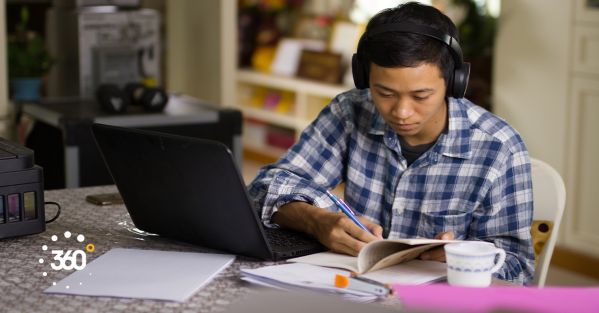6 Ways to Create a Homeschool Room on a Budget
For many families, this year’s back-to-school season means figuring out how to create an adequate learning space at home. If you’ve been looking on Pinterest, you might think you need a dedicated homeschool room that’s meticulously organized, decorated in bright colors and decked out with kid-sized furniture. And while that’s nice, we all don’t have spare guest rooms we can convert into a homeschool room. Kids will definitely be learning at kitchen tables and in corners of rooms this year. We also don’t have unlimited budgets to spend on preparing an Instagrammable learning space. After all, our country is in a recession and experiencing record unemployment levels. If you’re looking for easy and inexpensive solutions, here are some tips for creating a homeschool room (or just a little nook in your house) without overspending. 1. Take Inventory of What’s at HomeBefore you buy anything, go around your home and take note of what you already have. In years past, you may have opted to get new versions of everything on your child’s school supply list, but you don’t really need to purchase crayons and glue sticks when you already have them at home. If you have multiple children, save money by having them share supplies rather than buying separate stuff for each kid. Consider what furniture — tables, chairs, desks, etc. — you already have that could work for your homeschool setup. Think about where your children typically do their homework and if that would be sustainable for virtual learning on a laptop. 2. Think Outside the Back-to-School SalesYou may find good deals during back-to-school sales, but they aren’t the only opportunities for saving. Lorielle Hollaway, a homeschooling mom in St. Petersburg, Florida, said she finds better prices for school supplies a couple weeks after school starts when customer demand drops and retailers are trying to get the merchandise off the shelves. Another strategy for saving money is to grab cheaper store-brand products rather than name-brand ones. You can also find less expensive supplies at discount stores like Dollar Tree or Dollar General as opposed to office supply stores like Office Depot or Staples. If you have friends who are also setting up homeschool spaces, consider buying supplies in bulk from warehouse stores like Costco or Sam’s Club and splitting the costs. Make sure you’re getting a deal by checking if the price per unit is cheaper than buying items individually. 3. Shop Secondhand for GearAnother place Hollaway has found deals are at thrift stores. Browse your local secondhand shops for books, educational materials or even desks and chairs. Check children’s consignment stores too.Another place Hollaway has found deals are at thrift stores. Browse your local secondhand shops for books, educational materials or even desks and chairs. Check children’s consignment stores too. In addition, look for used items for your homeschool space at garage sales or on Craigslist. If your city has an active Buy Nothing group, that could be a way to get free gear for your homeschool room. If you have family or friends with older children, ask if they have anything they’re looking to pass down, like flashcards, puzzles or other learning aides. 4. Get Equipment from Your SchoolsIf your children will be doing virtual learning conducted by their schools, ask what types of equipment will be provided. Tech gear like laptops and tablets can be among the most expensive back-to-school equipment — but totally necessary for online education. Fortunately, many school districts across the country are providing students with the devices they need. Beyond having a way to access virtual lessons, ask what other types of resources you’ll be able to borrow from schools, such as calculators, rulers, protractors and art supplies. 5. Use Artwork for DecorIf your children like to doodle and draw, hang their artwork on the walls to liven up their homeschool space. Make an end-of-summer project out of creating posters or collages. Using washi tape is another low-cost way to incorporate pops of color. You can create an accent wall with washi tape in your homeschool space or use it to decorate a table or desk top. Once you no longer need a homeschool room, you can peel the tape right off. Chalkboard contact paper is an inexpensive, non-permanent alternative to using chalkboard paint in your space. Your chalkboard surface can double as decor and a surface for your kids to practice math problems and write vocabulary words. 6. DIY Organization SolutionsYou’re going to need something to store school supplies, papers and notebooks — especially if your dining room is playing double duty as your homeschool room and you’ll need to clear everything away before dinner. Instead of buying storage bins and containers, get creative with stuff you have at home. Grab empty glass jars from your recycling bin and use them as holders for pencils, crayons or other school supplies. Convert old cereal boxes into magazine holders where you can stash your kids’ notebooks and papers. Larger boxes — like from all the Amazon deliveries you’ve been getting — can be used to corral library books or to hold materials for a science project in the works. Cover boxes with wrapping paper or washi tape to make them look pretty.
Nicole Dow is a senior writer at The Penny Hoarder. This was originally published on The Penny Hoarder, which helps millions of readers worldwide earn and save money by sharing unique job opportunities, personal stories, freebies and more. The Inc. 5000 ranked The Penny Hoarder as the fastest-growing private media company in the U.S. in 2017. |
|
Routing #: 221379824
Sunmark is here to support our members and their families affected by the government shutdown by offering personalized assistance for those impacted. For more information, please visit your nearest financial center or call 866.SUNMARK
